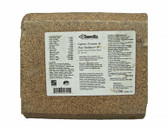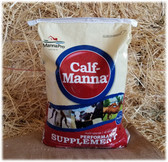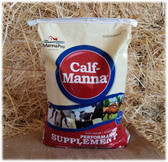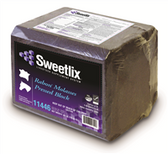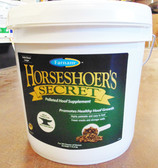 Loading... Please wait...
Loading... Please wait...- Home
- Animal Feed, Supplements & Treats
- Sweetlix Bloat Guard Supplement #738, 33 lb.
Sweetlix Bloat Guard Supplement #738, 33 lb.
Product Description
- Protects against frothy bloat in pastures when used as directed
- Allows worry-free utilization of high quality legume pastures as well.
- Consistent consumption results in continuous delivery of Bloat Guard® and thus reliable protection
- Weather-resistant blocks can be placed directly in pastures with cattle and require no special feeders.

GUARANTEED ANALYSIS:
Active Drug Ingredient(s):
| Poloxalene | 6.6% |
| Crude Protein, Min | 4.00% |
| Crude Fat, Min | 0.05% |
| Crude Fiber, Max | 12.50% |
| Salt, Min | 19.50% |
| Salt, Max | 23.00% |
| Potassium, Min | 1.80% |
| Iodine, Min | 43 ppm |
| Selenium, Min | 13 ppm |
INGREDIENT STATEMENT:
Molasses Products, Roughage Products, Salt, Petrolatum, Ferrous Sulfate, Manganous Oxide, Manganese Sulfate, Zinc Oxide, Zinc Sulfate, Mineral Oil, Calcium Iodate, Cobalt Sulfate, Sodium Molybdate, Sodium Selenite, Ethylenediamine Dihydroiodide and Calcium Carbonate.
For additional information, please contact your Sweetlix® representative.
DRUG CLAIM:
For control of legume (alfalfa, clover) bloat in cattle when consumed at the indicated rate.
FEEDING AND MANAGEMENT:
Feeding and Management
- To be fed at the rate of 0.8 oz. of block per 100 lb. of body weight per day. Example: 8 oz. (0.5 lb.) of block for a 1000 lb. animal daily.
- For adequate protection it is essential that each animal consume the total recommended dosage of SWEETLIX®Bloat Guard® Block Daily.
- Omit all salt from feed. Do not feed free choice sources of salt or mineral containing salt in any form. These blocks are an adequate source of salt.
- Begin feeding blocks continuously. Feed blocks and full feed dry non-legume hay at least 48 hours prior to legume (alfalfa, clover) consumption. Repeat when block consumption is interrupted to maintain control.
- Provide at least 1 block for each 5 head of cattle; add 1 additional block when each block has been half-consumed.
- The location of the block is extremely important for adequate consumption. Place blocks where cattle congregate (watering, grazing and loafing areas) in order to limit the distance an animal must travel to have ready access to a block.
- Controlled grazing practices (Strip Grazing) are recommended in order to limit the distance an animal must travel to have ready access to a block.
- In some instances, it may be necessary to confine cattle in a dry lot with additional SWEETLIX® Bloat Guard® Blocks for a period each day.
Bloat Guard® is the registered trademark
"Beware of Bloat!"

Bloat is a condition in ruminants (cattle, sheep and goats) that is marked by abdominal distention due to accumulated gas in the rumen. These gases are the normal by-product of digestion of feeds in the rumen and are usually harmlessly belched out by the animal. When the animal is unable to belch, bloat results. Left untreated, the gases compress the heart and lungs and can result in death.
Frothy bloat (also known as pasture or legume bloat) is most often associated with ruminants grazing lush, immature, legume pastures (alfalfa or clover) or cereal grain pastures (wheat, oats or rye); however, animals fed very high quality legume hay may also be susceptible. In frothy bloat, the gases mix with rumen contents to form very stable foam. Plant proteins are the primary foaming agent in the rumen contents. Because the gas is trapped in thousands of bubbles, it is impossible for the animal to eructate, or belch, to release the gas. It is also impossible to simply release the gas with a stomach tube or trocar as with other types of bloat. Frothy bloat develops very quickly and often your first indication of trouble will be a dead or dying animal.
The signs of bloat are obvious. A marked distention of the rumen (the left side of the animal as pictured above) appears suddenly. As bloat progresses, the skin over the left flank becomes more and more taut and cannot be pinched or “tented”. Difficulty in breathing will occur with grunting, breathing through an open mouth, tongue protrusion and a dropped head. In severe cases, death can occur in as little as a half hour from the onset of symptoms.
The Costs of Bloat
Due to the rapid growth of legumes or cereal grains under ideal conditions, a cattle producer can literally wake up one morning to dead cattle. Death losses of 1 to 5 percent are common during frothy bloat conditions and can go as high as 10 to 20 percent in severe outbreaks. Even sub-acute cases of frothy bloat are costly to cattle producers. The discomfort caused by mild bloat will cause cattle to eat and drink less (much like human indigestion), resulting in lowered production. Large aggressive feeders will be the most susceptible.
Treating Bloat
Since the gas in frothy bloat is trapped in foam, it is necessary to introduce an anti-foaming agent into the rumen. This is usually done through a stomach tube in severe cases. Because it is extremely easy to mistakenly pass a stomach tube into the lungs, inexperienced producers should call a veterinarian to perform this procedure. Some common anti-foaming agents are poloxalene (Bloat Guard®), vegetable oils and mineral oils. Bloat Guard® is the only FDA-approved medicat approved for prevention of frothy bloat in cattle. Bloat Guard® reduces the surface tension in the walls of the bubbles so that they can combine with other bubbles and burst, thus releasing the gas.
Prevention of Bloat
Because frothy bloat can cause death without warning, prevention is key for risk management. There are several management strategies that you can implement to help reduce the incidence of pasture bloat. These include:
- Do not turn hungry cattle out on fresh clover pastures.
- Fill cattle up on hay prior to turning out on lush, clover pastures.
- Do not graze lush pastures that are wet from excessive dew, frost or rain.
- Provide coarse hay at all times when cattle move to a new pasture.
- Feed SWEETLIX® Bloat Guard® Pressed Blocks as a preventative against bloat.
Safely Utilize High Quality Clover Without Worry
In summary, conditions are expected to be right for frothy bloat for many cattle producers. Bloat can be deadly and even mild cases result in production losses. Because onset of bloat is rapid, preventative measures are the best course of action. SWEETLIX® Bloat Guard® Pressed Blocks provide an easy, reliable method to deliver protective amounts of poloxalene on a daily basis. Only SWEETLIX® manufactures Bloat Guard® in a free choice block form. When used in conjunction with other preventative management practices, cattle producers can safely utilize these bountiful pastures without worry or loss. For additional information about SWEETLIX® Bloat Guard® Pressed Blocks or how they can be utilized in your production system..."

